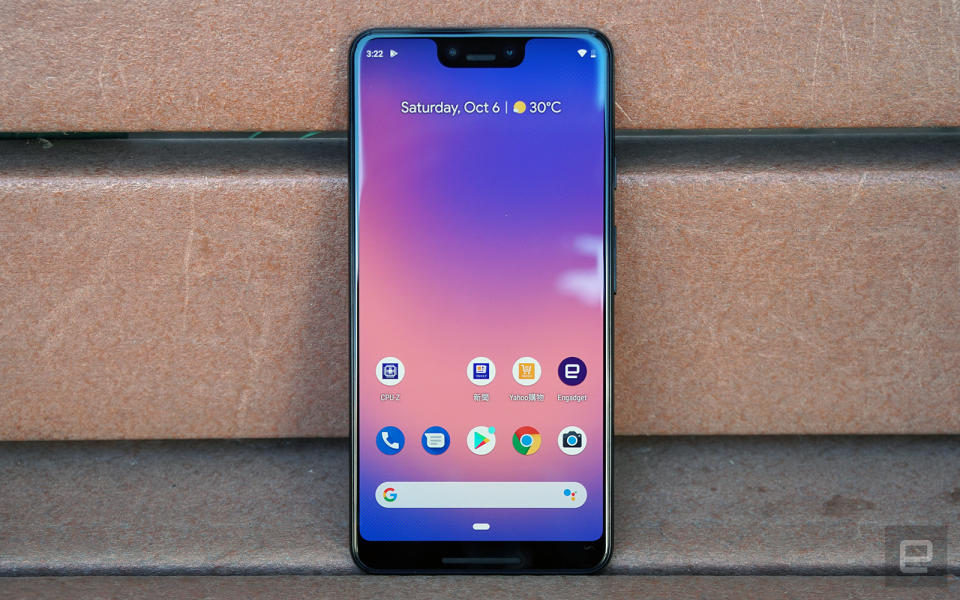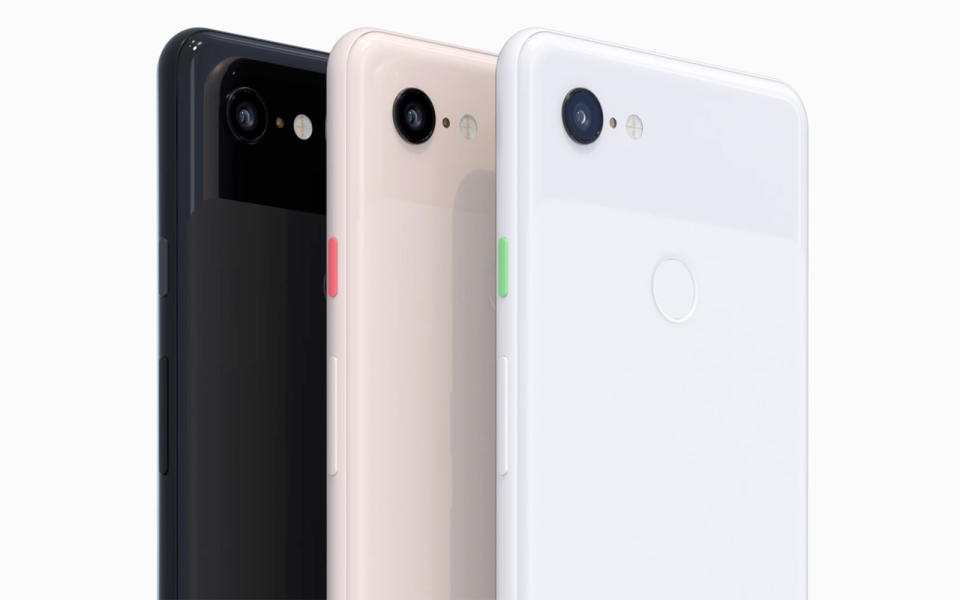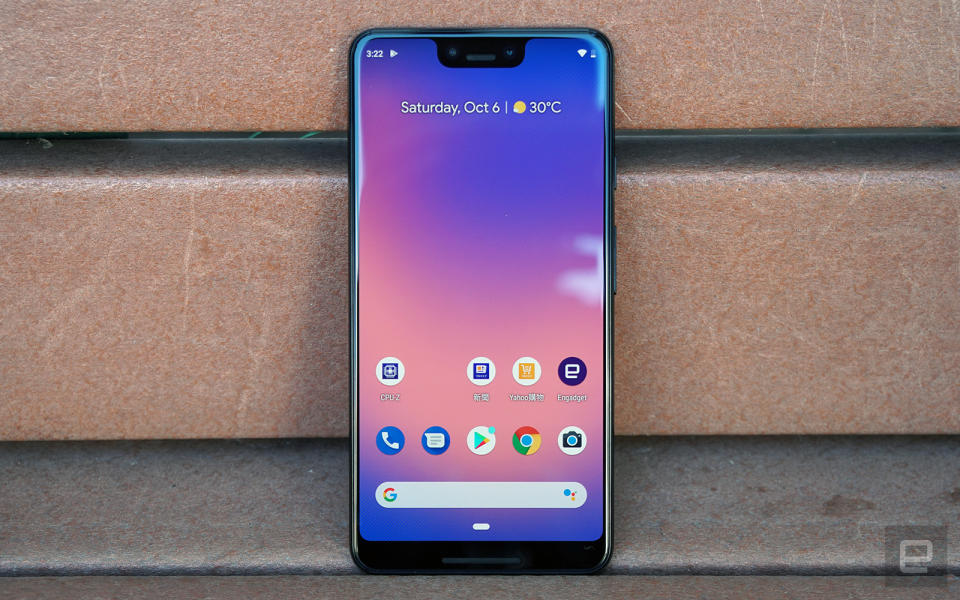Google announces the Pixel 3 and Pixel 3 XL
Look at the size of that notch.
Google's press conference is well underway in NYC, and the most important order of business is formally announcing the new Pixel 3 and Pixel 3 XL smartphones. To say we're already acquainted with the devices would be an understatement. Between our own early hands-on with the XL, the left-in-a-Lyft incident and many other leaks, we knew what we were in for: A pair of handsets that, on the hardware front, are not really designed to break to new ground, but to update the Pixel brand for 2018.
One thing that certainly hasn't changed a great deal between generations is the overall design. From the back, the Pixel 3 and XL look almost indistinguishable from last year's models. Instead of matte-effect metal up to the fingerprint reader, though, this time it's all glass. The matte portion is done with etching this time around, and the corners of this section are now rounded where they meet slick, upper surface, making the curve symmetrical with the bottom edge. Both new Pixels are also IP68 waterproof rated, if you were wondering.
Around the front, the changes are more apparent. the Pixel 3 sports a 5.5-inch OLED panel (2,160 x 1,080 resolution), while the bigger Pixel 3 XL hosts a 6.3-inch OLED display (2,960 x 1,440). Both have an industry-norm aspect ratio of 2:1, aka 18:9. The front-facing stereo speakers are apparently 40 percent louder this year, and you can test this claim with your free 6-month subscription to YouTube Music.

The Pixel 3 is almost a carbon copy of the Pixel 2 XL, with slim bezels flanking the top and bottom of the display. The Pixel 3 XL eliminates even more bezel compared with its predecessor, but it's not quite an edge-to-edge affair. There's still a bezel with speaker underneath the screen, and a notch up top -- yes Google's embracing the notch. The notch is one of the deepest and arguably one of the ugliest around, perhaps because the front-facing camera count has increased from one to two this year. On both new Pixels, you get two 8-megapixel selfie shooters. One's more suited to standard mugshots (f/1.8), while the other features a wide-angle lens (f/2.2) so you can cram the whole squad into the shot.

Two front-facing cameras can be found on many smartphones, but Google's almost bucking the more-lenses-the-better trend by sticking to just one primary camera. Both the Pixel 3 and Pixel 3 XL have a single, 12.2-megapixel sensor (f/1.8) on the back, but last year's Pixels have already shown us what magic Google can achieve with a lone lens. Naturally, unlimited cloud storage on Google Photos remains a Pixel perk, if only for three years (or rather, until the end of 2021).
Google's got a few new AI camera tricks for the Pixel 3 pair that are also coming to last year's phones soon. "Top Shot" is the next step in burst capture. Just as many other phones will take a few pictures when you prod the shutter and ask you to choose the best, the Pixel 3 phones do this last step for you, using AI to select your Top Shot. It'll take into account things like focus, framing and whether the subject is smiling or not. "Photobooth" is similar in that it does the same kinda thing for selfies, and throws Google Clips-like autocapture into the mix if it detects something interesting in the frame, no additional niche hardware required.
Other features include "Night Sight," which helps you take better photos in low-light (though it won't quite be ready for launch), and "Motion Auto Focus," which keeps focus from straying off your intended target. "Super Res Zoom" uses AI to enhance the quality of images and video taken with digital zoom, while "Playground" lets you add stickers and superheroes to what you've shot. You can adjust bokeh in Portrait Mode after the fact now, and Google Lens is also improved on the new Pixels, being able to work without an internet connection, for instance.
Beyond the camera experience, there are a few other new software smarts. Google's Duplex restaurant-booking feature, which allows you to book over the phone without having to actually talk to anyone, comes to Pixel phones first next month (in New York, Atlanta, Phoenix and the San Francisco Bay Area). With "Call Screen," the Assistant can take calls on your behalf and ask about their nature. It'll feed that info back to you so you can avoid telemarketers and block numbers without any awkward conversations, or tell someone you'll call back later if you're busy. This will be available in the US initially, and come to older Pixels in due course.
Like the Pixels that have come before this new duo, the core qualities are identical across both sizes of device. Both are powered by Qualcomm's octa-core Snapdragon 845 chip -- an expected upgrade over last year's 835 -- and 4GB of RAM (unchanged from the Pixel 2 and 2 XL). There's a new Titan M security chip for added peace of mind, too. Front of house is, of course, Android 9 Pie. Storage options come in at 64GB or 128GB, and no, you can't augment that with a microSD card. Similarly, the headphone jack hasn't made a triumphant return this generation.
The new handsets have pressure-sensitive sides like last year's models, too. Squeezes equal shortcuts, like launching the Google Assistant without having to wake it with magic words. Google calls this Active Edge, HTC calls it Edge Sense, Sony calls it Side sense, and we call it a novelty without a killer use case yet.
One of the truly new hardware features on the Pixel 3 and Pixel 3 XL is Qi wireless charging, complementing wired, 18W fast-charging that will apparently give you seven hours of juice in just 15 minutes. Wireless should top up the 2,915/3,430mAh batteries slightly faster than it does on some other phones, too, since the Pixels support 10W power transfer compared to the common 7.5W ceiling. You can achieve these kind of speeds with the new $79 Pixel Stand accessory. It's a wireless charging dock that also turns your phone into ersatz Google Home Hub. Other official accessories include cases for your new baby.
The new Pixel 3 and Pixel 3 XL are available to pre-order today in the US starting at $799 and $899, respectively, with shipping commencing October 18th. Both sizes will come in regular white and black finishes, as well as more flamboyant pale pink. You can grab them from Google's online store, or on contracts through Project Fi and bean-spilling Verizon. On October 21st, the new phones will hit 12 other markets, including Canada, Australia, several European countries including the UK, as well as parts of Asia.
Follow all the latest news from Google's Pixel 3 event here!



